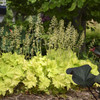Product Description
Heuchera 'Twist of Lime' PPAF (10)ct Quarts
Common Name: Coral Bells
Chartreuse-yellow leaves beg to be noticed and is perhaps one of our brightest yellow Heucheras. Ruffling becomes less pronounced as the foliage matures. For best yellow color, site in dappled shade or morning sun. Cream flowers appear in early summer.
Height: 8.0-10.0 Inches
Spread: 12.0-16.0 Inches
Scape Height: 18.0-20.0 Inches
Hardiness Zones: 4,5,6,7,8,9
Flower Color: White Shades
Foliage Color: Yellow shades
Part Shade to Full Shade
Average Water Needs
Average to Fertile Soil Quality
Bloomtime: Early Summer to Midsummer
Attracts Butterflies and Hummingbirds
Bee Friendly
Evergreen
Fall Color
Growth Rate: Medium
Easy to grow average soil; Heucheras will perform best in organically rich, humus, medium wet, well-drained soil with a neutral pH. Performs well in full sun in the north but prefers some afternoon shade in the south. If grown in full sun, consistent moisture is particularly important. They grow most vigorously and have the strongest colors when grown in partial shade (preferably afternoon shade). They can also be grown in full shade, but their growth rate will be very slow.
Coral bells are easy to grow and blend easily with most other perennials in the landscape. Because of their low, mounding habit, they are often used as edging along paths or in containers. Remove stems of faded flowers to encourage additional bloom. Foliage is essentially evergreen in warm winter climates, but the amount of retained foliage color in cold winter climates depends upon the temperatures. In cold winter climates, winter mulch applied after the ground freezes will help prevent root heaving. Clumps may be divided in the spring every 3 to 4 years.
Attributes: Border plants, Container, Cut flower or foliage, Edging, Mass planting, Salt Tolerant, Specimen or focal point plant, Deer resistant, Attracts butterflies and hummingbirds.
Heuchera 'Twist of Lime' is a vibrant and refreshing coral bells variety that brightens up shady gardens with its chartreuse-yellow foliage.
This eye-catching perennial forms a dense mound of ruffled leaves, each with a unique twist and curl, adding a playful touch to the landscape. The bright yellow-green color adds a burst of sunshine to shady spots and contrasts beautifully with darker foliage. In summer, 'Twist of Lime' produces delicate, creamy white flowers on slender stems, adding a touch of airy elegance to the display.
- Mature Size: 8-10 inches tall, 12-18 inches wide
- Flower Color: Creamy white
- Bloom Time: Summer
- Growth Habit: Mounding
- Sunlight: Part Shade to Full Shade (Best color in morning sun or dappled shade)
- Soil: Moist, well-drained
- Hardiness Zones: 4-9
Planting and Care:
- Planting: Choose a location with part shade to full shade. 'Twist of Lime' thrives in shady conditions but benefits from some morning sun or dappled sunlight to bring out its brightest colors. Avoid intense afternoon sun, which can scorch the foliage. Ensure the soil is moist and well-drained. Amend the soil with compost or other organic matter before planting. Dig a hole slightly larger than the root ball and plant at the same depth as the container. Space plants about 12-18 inches apart.
- Watering: Water regularly, especially during dry periods. Heuchera prefers consistent moisture but can tolerate some drought once established.
- Fertilizing: Apply a balanced fertilizer in early spring as new growth emerges. Avoid over-fertilizing.
- Mulching: Mulch around the plants with shredded bark, compost, or pine needles to retain moisture, suppress weeds, and protect the crown.
- Deadheading: Remove spent flower stalks to encourage continuous blooming and maintain a tidy appearance.
- Division: Divide clumps every 3-4 years, or as needed, to prevent overcrowding and rejuvenate the plant. Division is best done in spring or fall.
Special Considerations:
- Heuchera 'Twist of Lime' is a versatile and low-maintenance plant that adds a touch of vibrant color and playful texture to shade gardens, borders, and container plantings.
- Its unique foliage color and charming flowers make it a standout in any setting.
- It pairs well with other shade-loving plants, especially those with contrasting foliage colors and textures.
- Heuchera is generally deer-resistant and attracts pollinators like bees and butterflies.
Ten (10) plants in quart containers per flat (or tray).
Other Details
The most important part of the plant is its root system. Healthy roots are the foundation of a healthy, vibrant plant. The type of plug container used is based on the specific needs of the plants. Perennials offered as bare root traditionally perform better when planted as bare root.Planted in a specialized mix, potted plants have well established root systems. Top growth stage will vary depending on the current life cycle and time of year when shipped. In Winter and early Spring dormant plants may be shipped. Dormant plants may be planted right away, even before the last frost date.
Most bare root varieties are field grown for at least one season, though Hemerocallis and Hosta are grown for two seasons. The bulk of the soil is removed during the harvesting process and the tops of most varieties are trimmed back to the crown. They are graded, packed in shredded aspen or sphagnum moss and stored in freezers until ready to be shipped.
See our Container Sizes and Bare Root Perennials pages for more information.
Plant information and care is provided in the Overview section, Plant Genus Page and general information is provided in the Planting Care & Guides. Additional questions can be asked on each Plant page.
Plant Spacing: Using the maximum mature spread or width of a plant to guide spacing, ensures space to grow to full size. To fill an area sooner, plant them closer together. Just remember, future thinning or transplanting may be needed.
Water: Keep a close eye on newly planted perennials, especially throughout the first growing year. Most early plant loss is due to too much or too little water!















